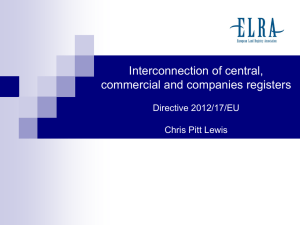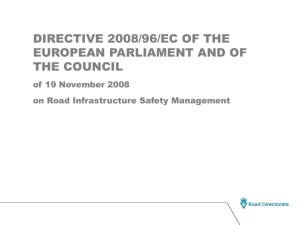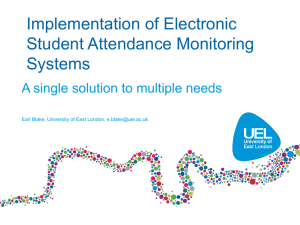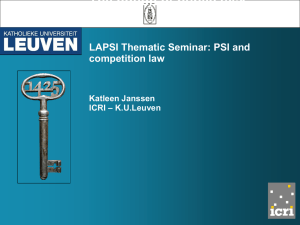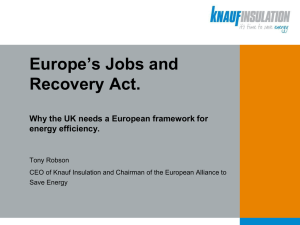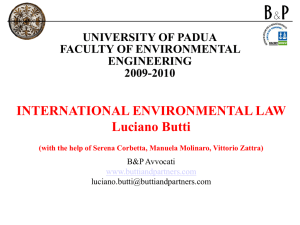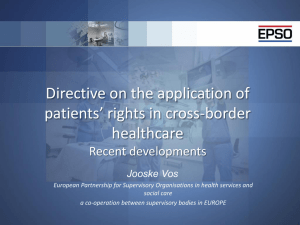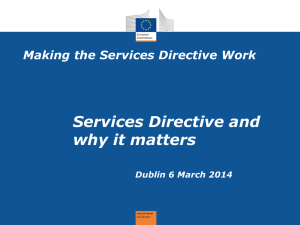Directive 2012/17/EU - European Commerce Registers` Forum
advertisement
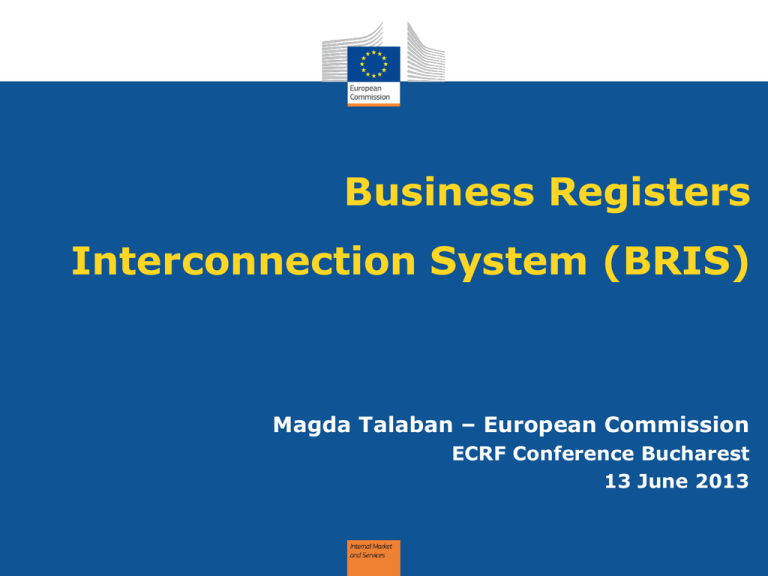
Business Registers Interconnection System (BRIS) Magda Talaban – European Commission ECRF Conference Bucharest 13 June 2013 Outline Directive 2012/17/EU BRIS overview Business registers survey Roadmap and on-going work Challenges 2 Directive 2012/17/EU 3 Background Need to improve transparency and access to company information at EU level Need to provide updated reliable information on companies and their foreign branches Facilitate cross-border communication between business registers Increase legal certainty and confidence in the internal market 4 Directive 2012/17/EU Amendments to three company law directives - Directive 89/666/EEC - Directive 2005/56/EC - Directive 2009/101/EC New provisions – establishment of the business registers interconnection system (BRIS) Obligations and tasks both for MS and COM 5 Phased implementation By 7 July 2014 Transposition (I) By 7 July 2015 Adoption of technical specifications for BRIS (implementing acts) No later than 2 years after Transposition (II) adoption of implementing acts * Post-transposition / System LIVE Application of Directive * Cf. Art 5 (2) (2) after the adoption of implementing acts, COM will publish the final date for application of remaining provisions 6 BRIS overview 7 Business Registers Interconnection System (BRIS) Citizens BRIS = MS Business Registers, the Platform and the Portal Other companies Administrations 1 Search E-Justice Portal MS BR A 2 Cross-border Mergers MS BR C Information on companies and branches cross-border merger notification Following notification from BR A, BR C strikes off merging company EU Platform Central Platform MS BR B 3 notification on company winding-up/insolvency and striking-off Foreign branch disclosure Following notification from BR B, BRs D and E strike-off the branches MS BR D MS BR E Business registers survey 9 Business Registers survey Purpose Identify state of play: Understand and learn how the business domain is managed by MS BRs Identify gaps between current situation and requirements in the Directive Replies: 27 (out of 30) 10 Business registers covered by the Directive • 18 (67%) MS have only one central BR. • 7 MS have one central BR plus other regional or local registers (the ones with regional registers have no local registers and vice-versa) • 2 MS do not have a central register but have regional and/or local registers, and they are interconnected. Functional observation It seems feasible to access all BRs through one single point of access as all MS BRs are somehow interconnected at central level. 11 Types of entities covered by business registers 23 MS state that they keep information on other types of entities in addition to Limited Liability Companies. The additional types of entities are mainly the following ones: Directive Compliance Limited Liability Companies, as defined in the Directive are currently being registered by all MS BRs. 12 Documents and particulars disclosed by business registers 19 (70%) MS disclose a rich range of other documents and information beyond those required by Directive 2009/101/EC. Some of the documents and particulars specified by the MS (some of them common to a reduced number of MS) are the following ones: Directive Compliance All MS publish the whole set of documents and particulars specified by the Directive. 13 Company Unique Identifier • Less than half of the MS use Unique Identifiers for registering companies, different from the Registration Number. • For most of those using UIDs, the structure of the ID does not conform the one described by the Directive. 2 MS state to be conformant with the Directive's mandated structure. • Those MS BRs with UIDs rarely use their UID for cross-border operations. ! Directive Compliance Currently very few MS use Unique IDs for companies which is similar to the structure specified in the Directive. 14 Company Unique Identifier • The majority of the registers that have a company-UID use it for national inter-operations, mainly for communication with their Tax Agencies. • Few registers (only 4) use their nationally-defined company UID for cross-border operations, mainly in the context of current projects and pilots with other MS . (*) One MS states having a UID but does not provide information on its use. 15 Branch Registration • Most MS BRs register branches (only 2 do not). • Amongst the 25 MS that register branches, only 1 MS links the branch with its parent company through its identifier. Directive Compliance Currently most MS state that their BRs register the branches of foreign companies., Most MS do not link the branch to the company through the branch identifier. ! 16 Branch Unique Identifier • Only 3 MS out of 25 structure the branch ID as specified in the Directive • 6 countries state to use it for internal communication with other authorities, and 11 for cross-border operations Directive Compliance ! Very few MS declare to use branch-UIDs conformant with the Directive-defined structure. 17 Fees for disclosure of information and particulars on companies (Art. 2 of Dir. 2009/101) • The majority of MS charge for most of the information on companies. • 5 MS offer the information on companies 100% free. • Other 4 MS offer most information for free. ! Functional observation BRIS will have to propose a flexible payment solution. 18 Fees for disclosure of information and particulars on branches (Art. 2 of Dir. 89/666/EEC) • The majority of MS charge for most of the information on branches. • 5 MS offer 100% of the information on branches for free. • Other 4 MS offer almost all documents for free. ! Functional observation BRIS will have to propose a flexible payment solution. 19 Comparing free information about companies and branches • There is more free information on branches than on companies. • Companies accounting (Art 2f) and branches accounting (Art. 2.1h) information is not free for most countries. 20 Search criteria and mechanisms • All MS BR offer the Company's Name and Registration Number as search criteria. • Almost half of the MS BRs also offer Person Name, Legal Form and Region as search criteria. Functional observation A harmonised set of common search criteria and mechanisms seems feasible. 21 Roadmap and on-going work 22 technical road map: global overview 2013 Q3 Q4 Q1 Q2 Q3 2014 Q4 Q1 Q2 2015 Q3 Q4 Q1 Q2 2016 Q3 Q4 Q1 Q2 2017 Q3 Q4 Q1 Q2 Q3 Q4 Q1 Q2 Implementing Act Adoption Top->down reading Planning & Analysis Strategic Decisions Development Testing Pilots Roll-out MS User Support & dissemination… Operation & Maintenance … t0 Timeline tf December 2013 October 2014 March 2016 March 2017 23 technical road map: planning & analysis overview Planning and Analysis Team organisation, Road Map, Project Scheduling & Management tasks, … Top->down reading Practices Survey Business Practices Survey Technical Practices Survey Survey conclusions: high level analysis Operation & IT Services Art. 4c(i) Use Cases Art. 4c(i) User Requirements Capturing Questionnaire Interviews Meetings Identification and description of Business Requirements Strategic Decisions Timeline December 2012 April 2013 December 2013 24 technical road map: practices survey conclusions Planning and Analysis Practices Survey Business Practices Survey Survey conclusions: high level analysis Technical Practices Survey Operation & IT Services Art. 4c(i) Top->down reading Identification and depiction of BUSINESS PROCESSES Identification and depiction of COLLABORATIONS AMONGST STAKEHOLDERS Identification and listing of BUSINESS RULES Identification and depiction of EXCHANGED MESSAGES & DOCUMENTS Use Cases Art. 4c(i) Identification, depiction and description of the PLATFORM & PORTAL SERVICES Deliverables: Practices Survey Vision Document • • Best practices on Business Registers interconnection, payment modes, etc. Best practices on information exchange architectures, payment facilities, standard communication and protocols, access and security, etc. • • • December 2012 April 2013 Selection of STANDARDS for MESSAGE STRUCTURING & EXCHANGING PLATFORM SERVICES AND USE CASES PORTAL SERVICES AND USE CASES High Level Collaboration DIAGRAMS DIAGRAMS & Use Case Tables (Narrative description of the Case, Actors, System preconditions and post-conditions, etc.) Narrative contextualisation and comments on the analysis December 2013 25 technical road map: technical specifications overview Planning and Analysis Strategic Decisions Technical Specifications Unique Identifier Art. 4(h) Top->down reading Information Exchange Model Art. 4c(d),(e),(f) Communication Methods + Protocols Art. 4c(a), (b) Operational, Storage & Management Model Art. 4c(g) Portal Interface, Search Engine & Content Delivery Art. 4c (c), (j), (l) Access and Security Model Art. 4c(c) BRIS' SLA Art. 4c(m) Payment modalities Art. 4c(k) MS BRs Interoperability (interconnection system) Art. 4c(i) MS' Access Points Integration Model Art. 4c(n) Technology Selection Proofs of concept Implementing Act elaboration Implementing Act Adoption (incl. adoption by COM) Meetings, discussions, document revision Decision concerning the System Supplier Timeline October 2013 April 2014 Development October 2014 26 Challenges 27 Basic principles Do not reinvent the wheel Identify and assess the existing knowledge, projects, solutions… Re-use as much as possible Models and approaches, architectural proposals, building blocks, business vocabularies, semantic assets Keep open and standard, i.e. do not get enslaved by proprietary solutions; do not develop ad hoc specifications or software core modules Minimize the impact on the Member States systems Where possible, try to re-use specifications, techniques and solutions already used by the MS L'embarras du choix A rich world of knowledge and experience related to the BR domain and to systems/ BR interoperability Interoperability (Architecture, semantic IOP, re-usable building blocks, etc.) Large Scale Projects, e.g. e-Codex, PEPPOL, STORK, e-Sens … ISA and W3C specifications, e.g. Business Core Vocabulary, DCAT-AP, ADMS… Commission internal projects/ systems, e.g. DG JUST (IRI), DG MOVE (ERRU and RESPER), TAXUD, SANCO, ESTAT (EGR), CIPA e-Delivery, etc. Registers related European platforms, pilots and projects BRITE and EBR ECRF xEBR and XBRL RMS Interegisters LEI Others Main challenges Meet deadlines in the Directive: manage the available time for making the optimal strategic decisions and implementation of the Directive. Best value for money: choose the solutions that best fit the available budget and which require the minimum cost for both the Commission and the Member States. To overcome challenges Remember the objectives of the Directive Bring benefits to users (businesses, public authorities) of the internal market Communication and cooperation between stakeholders Work together towards a common solution 31 Questions and Answers Contact: markt-bris@ec.europa.eu 32
